When the Time Comes: Stories from the end of life
When the Time Comes: Stories from the end of life
by Maree Ticehurst
Thursday, September 30, 2021
Dr Magnolia Cardona & Nurse Ebony Lewis’s book – When the Time Comes: Stories from the end of life – published by Hammersmith Health Books, is a collection of rich and incredibly honest true short stories told by those who are suffering from irreversible and terminal conditions. It offers powerful insights into the parallel experiences of the caregivers of people who are approaching the end of their life and health practitioners who have spent their career’s dedicated to treating, managing, and caring for their dying patients and supporting their families through the process.
The contributors have generously and openly shared their own lived experiences and perspectives of death and dying and have given us an honest snapshot into both the struggles, the journey and acceptance of death and dying. As the title suggests “when the times comes” is a call for preparedness on the inevitable. However, in our society, this is something we tend to shy away from discussing with our loved ones and doctors. As Zen Buddhist teacher, civil rights activist and author Joan Halifax says “… Death happens. It is just death, and how we meet it is up to us”. This rings particularly true for this wonderful, deeply raw and at times vulnerable and tear-jerking collection of short stories. The authors are able to convey an indisputable message that the way we die is something that we can in fact have control over and prepare for, just as one prepares for birth and other life milestones.
The 22 true short stories narrated from diverse cultural, age groups, and health system perspectives deliver a thought provoking and honest message to all of us, that a good death is possible, and if we can, we should prepare for our death in advance.
There is the added underlining theme in several of the chapters that for many, they did not know that death was nearing or they did not know what their loved one would want in terms of care and treatment when the ‘time came’. Importantly, what we may want for ourselves may differ to what our loved ones may want at the end of life.
Strategies such as having an advance care directive (living will), talking with our friends, family and health care team on what we determine acceptable treatment and care when we are nearing the end, emerge loud and clear. Importantly, while discussions around death and dying can be difficult and highly emotive for some, it transpires that they are not only rewarding, but a gift for others and something that we should all be doing to transform our death-avoiding society into one that embraces supportive and palliative care.
Throughout the book, after each story there are reflection questions, to prompt readers to reflect on the underlying themes of each story and what they may want for themselves when their time comes. A list of additional websites and readings at the end of the book for those wanting further information is a bonus. After 40 years working in nursing homes and witnessing deaths on site and repeat transfers to hospital near the end of life, I welcomed the news that this book is now out there to familiarise the public with what can be done to ensure our elders die with dignity and on their own terms if the natural end is in sight.
The novelty of this book rests in that it is one of the few resources for the public where practical advice comes across implicitly without a textbook flavour or format, but with all the enticing short lessons and contradictory emotions relevant to such a journey. I particularly enjoyed the fact that each story was unrelated to the other, so readers can go through the table of contents and choose to read the chapters in any order, picking first the chapter titles that resonate with their situation. But it is highly recommendable to read the introduction and preface, as they both set the context for why it is a good idea for all sectors of society to read the book. I would recommend to just read one chapter at a time, and encourage you to share your learnings with others to start critical end-of-life conversations. Having these conversations will help enhance your ability to normalise these end-of-life conversations.
If you are a teacher or a senior clinician, you could recommend this book to your students, because it reveals those perspectives that we don’t often have time to explore in our busy practice, and it enlightens young trainees about eliciting older people’s values and preferences before it’s too late, while they still have mental capacity.
This book is a must read for health professionals. It will hopefully arm our future health professionals with the knowledge and skills when they will inevitably be caring for those nearing the end of life.
The book’s authors, Doctor Cardona and Nurse Lewis, are experienced clinicians and highly recognised palliative care researchers. They have a passion for improving the end-of-life care experience for older adults, their caregivers and clinicians, and ultimately to see the prevention of unnecessary suffering and over medicalisation of treatments for older people approaching a natural death.
A book review by Maree Ticehurst, Registered Nurse Aged Care, NSW Australia

